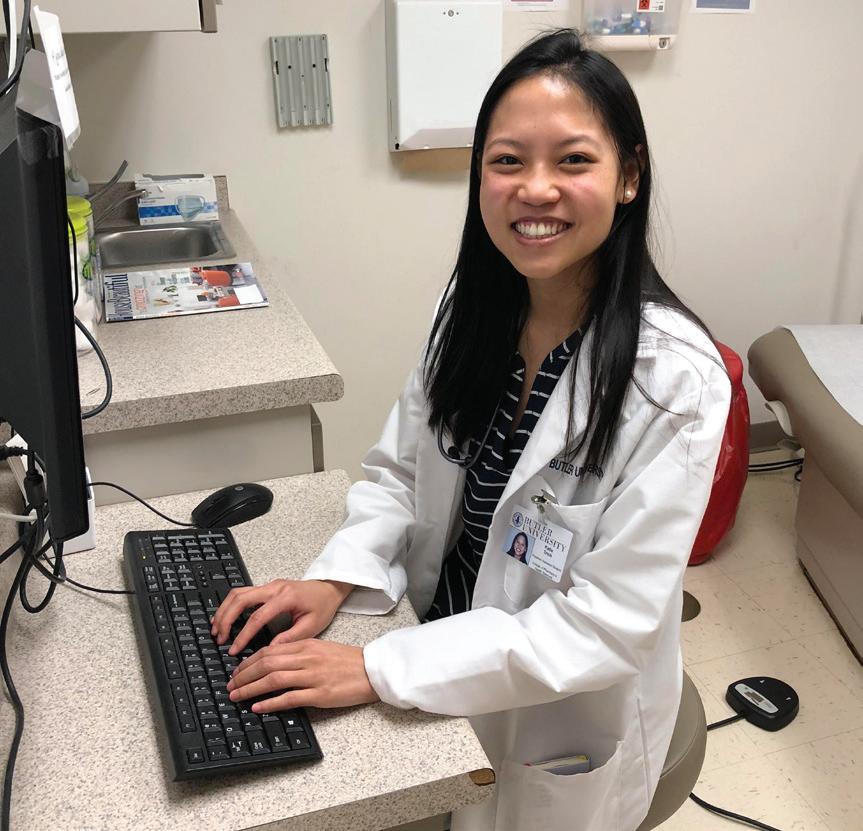
2 minute read
A DAY IN THE LIFE: WITH
HOMETOWN: Mason, OH
UNDERGRADUATE DEGREE: Health Sciences
KATIE TRINH ’18
TRINH SHARES WHAT A TYPICAL DAY AS A STUDENT IN HOSPITALIST INTERNAL MEDICINE LOOKS LIKE.
5:45 AM—Slowly wake up and get ready for the day. Brew coffee, pack a small lunch, and eat a bowl of cereal before I head out the door.
6:50 AM—Drive to Lafayette East Hospital. Listen to PA podcasts on the way to fit some learning in.
7:50 AM—Arrive at Lafayette East Hospital. Prepare for morning rounds by reviewing patient vitals, labs, meds, and new imaging studies. Scribble questions on paper for my attending physician.
8:45 AM—Attend multidisciplinary rounds. Talk with physical therapists, social workers, nursing staff, dieticians, and pharmacists about concerns and changes in a patient’s treatment. Meet my attending and discuss patients for the day.
9:30 AM—Make rounds with my patients. I start with the sickest patient, typically in the ICU, and work my way through the cardiac care unit, medical-surgical unit, and observation unit. Find time in between to write progress notes on patients.
Someone recently asked Katie Trinh ’18 from Mason, Ohio, what she was most proud of and she replied, “How far I’ve come in my clinical knowledge and training.” She shared that the “early mornings and late nights of her didactic year were worth it.” The ‘aha’ moment she experiences in the clinical setting is gratifying because she independently applies her classroom knowledge in a real world setting.
Trinh recognizes how blessed she is with the education, opportunities, and clinical experiences provided by the Butler PA Program. A unique and favorite moment during rotations was during her women’s health rotation where she had the opportunity to visit the Indianapolis Zoo and assist in an ultrasound on a female orangutan. She regualry reflects on the long hours spent in the OR, the insightful moments with patients at their bedside, and the many procedures performed over the past several months. “It’s true when they say that the days are long and the years are short because the past three years have been a whirlwind,” she expresses as she nears the end of her PA education. As the number of rotations left begins to dwindle down, Trinh is eager to begin her career as a practicing PA. She is excited to treat her own patients and build relationships with them.
When Trinh is not studying or at the hospital she can be found cooking, reading a book, or at a Butler basketball game. She plans to stay involved with the Butler PA Program in the future.
NOON—Eat lunch while researching patient diseases and treatment. I try to be as thorough as possible in their care.
1:00 PM—Meet with my attending and update him on my patients. Talk in depth about their treatment and what specialists may need to get involved.
2:15—My attending is paged from the ED about a new admission. Go to the ED to perform a complete history and physical exam.
3:30 PM—Receive a page from the cardiac care unit. A patient complains of shortness of breath. Run upstairs to perform a quick H&P exam.
4:30 PM—Get discharge papers ready for a patient from the medical-surgical unit. The patient had hip surgery and will be transferred to a rehab facility.
5:00 PM—Check that all charts have been cosigned and all orders have been placed. Time to head home.
6:00–8:00 PM—Throw a frozen pizza in the oven for dinner. Watch Shark Tank with my roommate for some needed R&R.
9:00 PM—Log patients on E-value and study for my end of rotation exam until I can’t keep my eyes open. Then it’s lights out.








